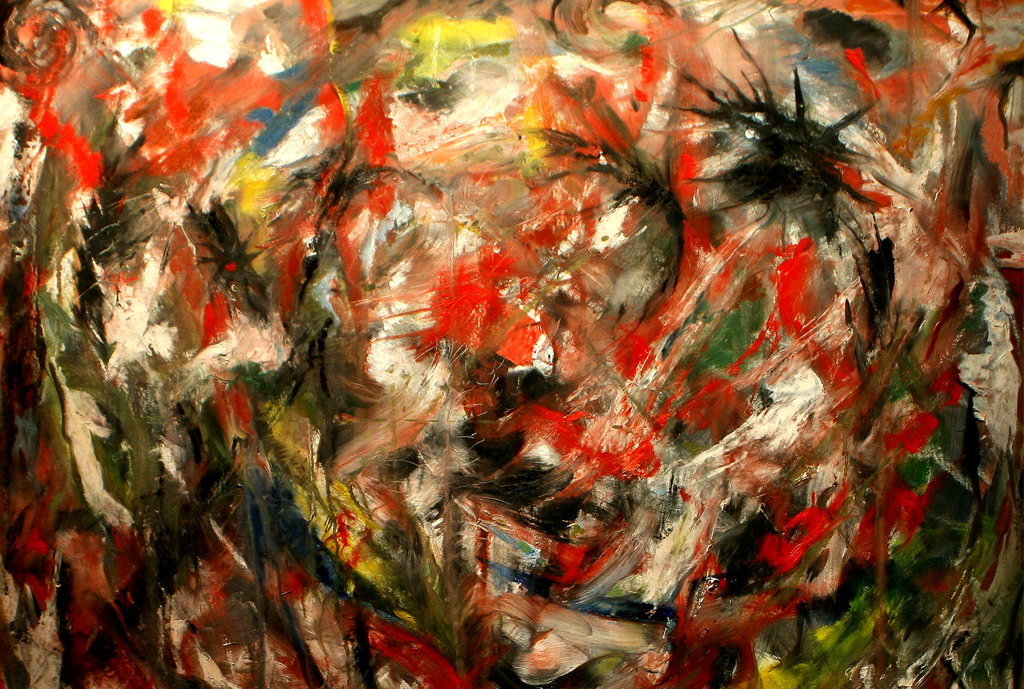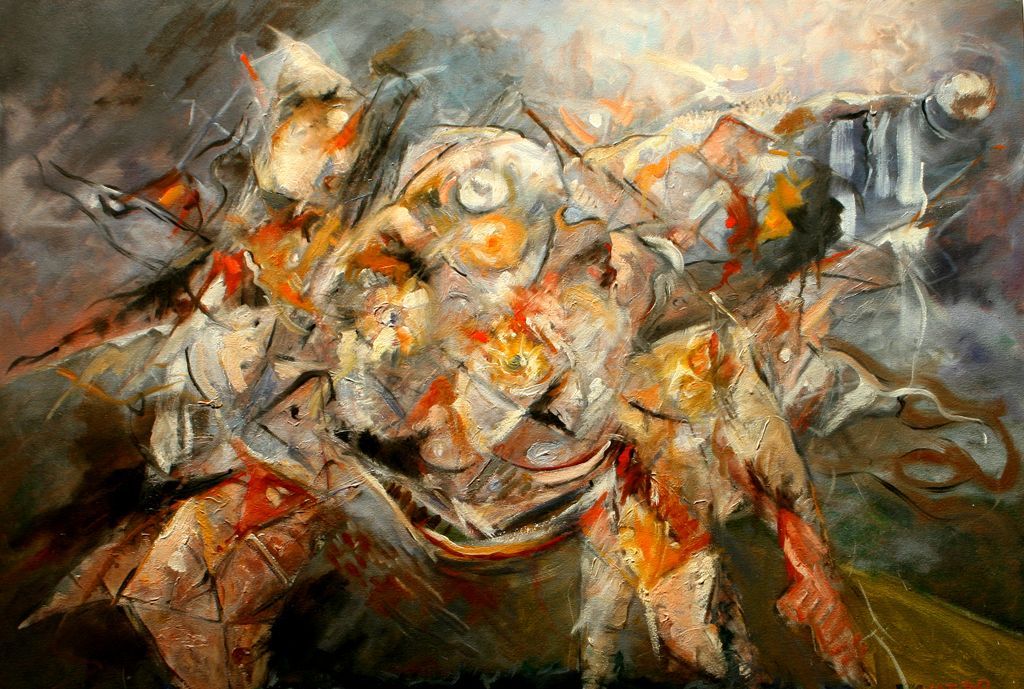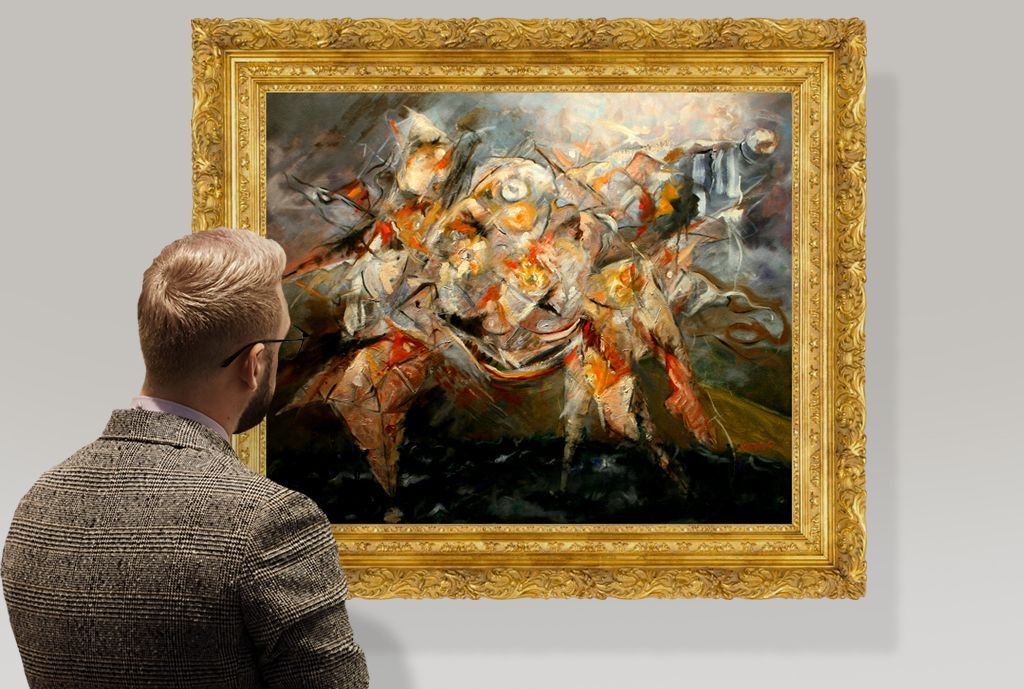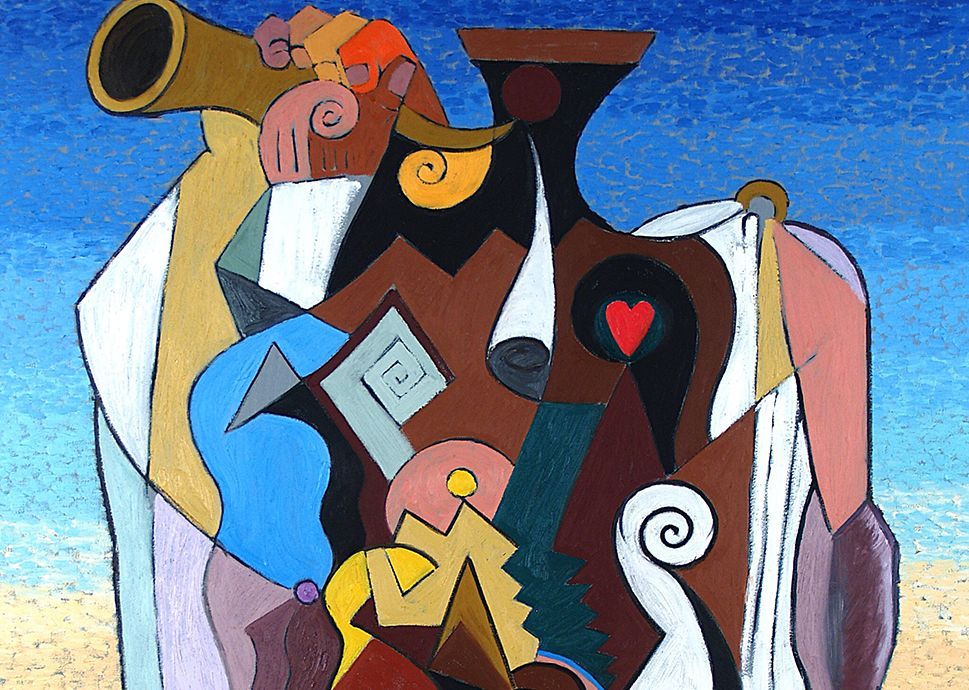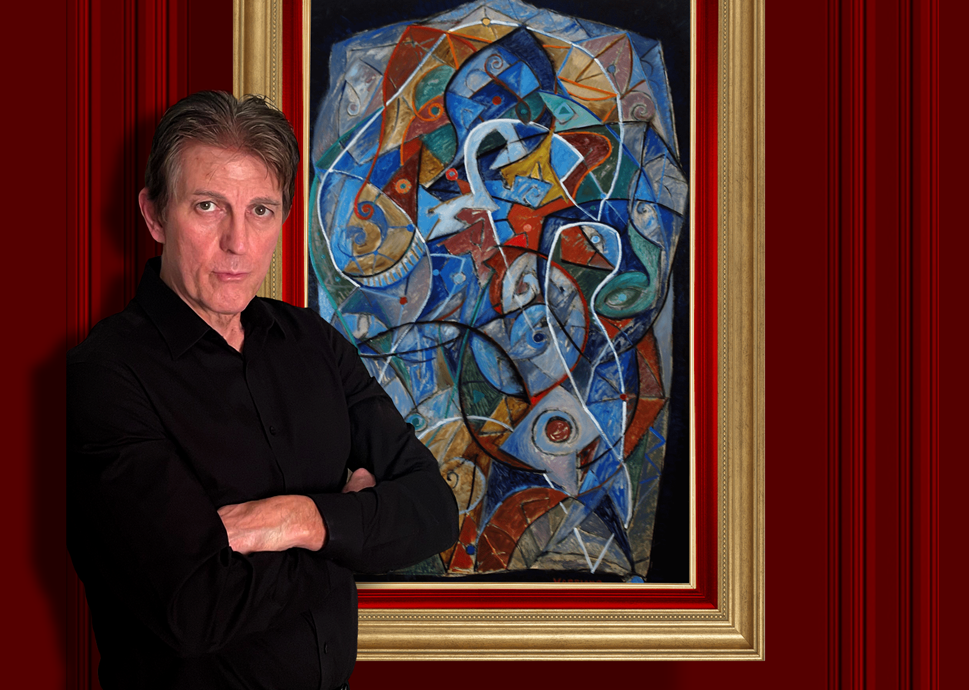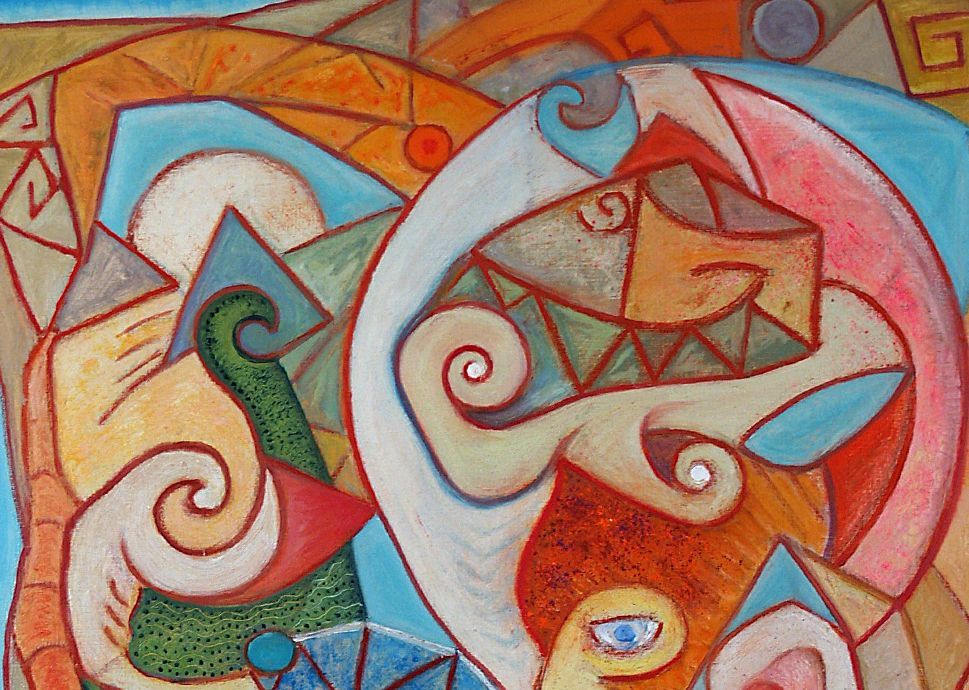Essay
Essay
John Varriano, American Artist Takes on Mythological Motifs in Art
By: Maria Loredan Avington
Entering the studio of John Varriano, one is immediately impressed by the sheer scope of artistic achievements one encounters. Some paintings, like “Red Square,” have a decidedly geometric and linear aspect, illustrating Varriano’s affinity for higher mathematics and physics. Varriano refers to the technique he used in Red Square as “Abstract Structuralism,” one of several pioneering forms of abstract art developed during his thirty-plus years as an artist.
Unexpectedly, in Red Square, it is not the shapes that take up space but the color. In this painting, Varriano substitutes color for gravity, creating a visual language in which art and science perfectly align. We are not quite sure if the objects are moving or pulsating, whether they belong to this reality or another. In viewing Red Square, I am reminded of the 19th-century novel, “Flatland,” by Edwin Abbott Abbot, and I desire to know if these forms are aware of their existence and if they communicate with one another. Whether intentional or not, Varriano's work arouses these types of fantastic ruminations.
Representing a different artistic triumph than his sharply constructed dimensionalities is “Catharsis,” a free-wielding explosion of creative force that highlights Varriano’s fluency with abstract expressionism. In its creation, Varriano attacked the canvas, applying paint with a mixture of brushes, palette knives, and diverse tools to achieve a unique expression. The work required intense physical endurance, mental concentration, and emotional energy.
Among others, the splendor of Varriano’s “Abstract Crystalism” stands out; it is a style he defines as the faceting, dissecting, and restructuring of form and space with the flattening of shifting perspective and the use of brilliant color. The Crystalism paintings pop with extraordinary vibrancy and motility. As I marvel at all his makings, my attention is drawn to the “Fall of Icarus,” a powerful and evocative telling of the mythological story in abstract terms.
Fall of Icarus stands at 30 inches by 36 inches and was completed in 1994. Mythological motifs have occupied a substantial part of Varriano's career and represent some of his most profound images. As he prepares for an upcoming exhibition featuring several of his new mythological themes, it seems fitting to examine an earlier work. A study that includes the man and his art.
Enamored with heroic and mythological motifs since childhood, Varriano has had a long and intimate relationship with their deeper meanings and nuances. The stories and symbols that bubble up from the unconscious and are part of humanity’s shared heritage appear to Varriano in what can only be termed visionary form. For Varriano, what is particularly enthralling about myths is their ability to speak and direct us toward higher, loftier truths. “Each time we turn to them, they reveal something new, which can never be completely discerned or exhausted.” Like many ancient, venerable stories, Icarus’s Fall resonates profoundly and personally with the artist. The creation of Varriano’s painting, bearing the same name, coincided with a period of severe and intense inner struggle, one Varriano describes as “A soul yearning to fulfill its destiny and finding itself burned in the process. Icarus’s tragedy appeared partly prophetic; from one observation, the fall was inevitable, but from another, it seemed senseless and only added to my agitated state, a story looming insufficient and incomplete. As I began work on the piece, I knew I had to let the forces inside me lead the way. I had to allow the painting to become what it desired, and in its creation, it would reveal to me what I needed to understand intellectually and express artistically."
Varriano presents Icarus in those fleeting moments when he realizes the cost of his ecstatic, soaring desire. Having flown too close to the sun, the wings his father, Daedalus, fashioned him begin to burn. Varriano uses a fiery palette of crisp oranges, reds, and icy steel blues to bring the ferity of the sun and the emotional state of Icarus sharply into focus.
At first glance, there appears little that is human in Varriano’s depiction. Completely rendered in abstraction, Varriano has given us an external portrayal of Icarus’s inner turmoil. There seems to be an eye in the center of the head, and I wonder why there is only one. Sensing my query, Varriano confirms the answer I’ve begun to perceive intuitively. “When we are in extreme distress, do we not become exceedingly focused, and do we not begin to see with a unified, penetrating perception?” The answer is straightforward, literal, and excellently fashioned. This is part of Varriano’s mastery, the ability to implicitly and explicitly reveal things in his paintings. We are drawn in and captivated by layer upon layer of artistic expression.
Moving our sight down the center of the canvas, we encounter what we can assume to be the body, puffed up and slightly rounded, as though bursting with innumerable, uncontrollable feelings. Varriano awakens our emotional understanding through shape, color and movement. The wings that once stood as a symbol for Icarus’s freedom have become his downfall and are now jagged and ravished by the flames. They too, seem to cry out in anguish. Then there is the sea: dark blue and green, ominous and violent in mood and texture but also mysterious and undoubtedly deep.
For millennia the fall of Icarus has been a cautionary tale about flying too high and being cast down by our folly. Varriano has thoughtfully and provocatively conveyed this idea but one can also recognize a subtle intimation that the painting communicates something more. Varriano’s abstract paintings require time to contemplate and an opening of the mind if we are to experience their rich, layered meanings and the mastery of the artist.
According to the Greek myth, Icarus’s father, Daedalus built the paradigmatic labyrinth for King Minos of Crete to secure the man-bull Minotaur begotten by his wife Pasiphae. Initially pleased by the craftsman’s work, Minos, later angered by Daedalus’s decides to imprison him and his son in the maze. Possessing an ingenious mind, Daedalus creates two pairs of wings for him and his son to escape and fly to the island of Sicily. He cautions Icarus not to fly too high lest he be burnt by the sun nor too low lest the sea water dampen and weigh down his wings. Overcome with enthusiasm and feeling an exaltation in his stature, Icarus unwittingly flies too high and close to the sun. A visual storyteller, Varriano used a palette of deep deep, somber reds melding into vivid, vibrant, oranges, that transform into silvery blues, and culminate in iridescent whites. With his choice and application of color, Varriano presents us with the transmutation of fire: as it burns hotter it becomes brighter, altering its qualities progressively from red to white. In the esoteric scripts of the ancient world, this type of transfiguration was often regarded as a process that purifies the baser characteristics to uncover what is of more refined and excellent value.
Looking to the upper left portion of the canvas, we encounter a dark sky filled with smoke. Surprisingly, the sky is opalescent on the right, so much so that we might imagine a benevolent voice speaking to us through the parting clouds. While the story of Icarus is one regarding the cost of overzealous ambition, the warning not fly to low is equally dangerous.
In its most literal intepretation, the myth is a warning to maintain balance. But! And this bears a resounding exclamation mark for Varriano, “Anyone who has sought higher heights knows that balance is not easily achieved nor maintained. “ Punishment from the gods, in the form of failure and fall, are often encountered on the path we tread. However, who the gods punish, they may also redeem.'
Every human being who has stretched out their hand toward a higher aim has, in their turn, faced the trials of fire in one form or another. Like our tragic hero, Icarus, great suffering is often associated with our rising. A test of resolve and endurance. Painful though it may be, through that suffering, there is a possibility of future redemption. Vaarriano imparts this idea through the transformation of fire and a partially candescent sky, and in so doing, indirectly communicates to us to persevere regardless of circumstances.
The burning, Icarus's or our own, should never be accepted as the tragic finale because a phoenix may be born from the ashes. For the artist, the painting is a reminder to arise from adversity and transfigure life's challenges into the glistening fire of courage and creativity.
John Varriano, American Artist Takes on Mythological Motifs in Art
By: Maria Loredan Avington
Entering the studio of John Varriano, one is immediately impressed by the sheer scope of artistic achievements one encounters. Some paintings, like “Red Square,” have a decidedly geometric and linear aspect, illustrating Varriano’s affinity for higher mathematics and physics. Varriano refers to the technique he used in Red Square as “Abstract Structuralism,” one of several pioneering forms of abstract art developed during his thirty-plus years as an artist.
Unexpectedly, in Red Square, it is not the shapes that take up space but the color. In this painting, Varriano substitutes color for gravity, creating a visual language in which art and science perfectly align. We are not quite sure if the objects are moving or pulsating, whether they belong to this reality or another. In viewing Red Square, I am reminded of the 19th-century novel, “Flatland,” by Edwin Abbott Abbot, and I desire to know if these forms are aware of their existence and if they communicate with one another. Whether intentional or not, Varriano's work arouses these types of fantastic ruminations.
Representing a different artistic triumph than his sharply constructed dimensionalities is “Catharsis,” a free-wielding explosion of creative force that highlights Varriano’s fluency with abstract expressionism. In its creation, Varriano attacked the canvas, applying paint with a mixture of brushes, palette knives, and diverse tools to achieve a unique expression. The work required intense physical endurance, mental concentration, and emotional energy.
Among others, the splendor of Varriano’s “Abstract Crystalism” stands out; it is a style he defines as the faceting, dissecting, and restructuring of form and space with the flattening of shifting perspective and the use of brilliant color. The Crystalism paintings pop with extraordinary vibrancy and motility. As I marvel at all his makings, my attention is drawn to the “Fall of Icarus,” a powerful and evocative telling of the mythological story in abstract terms.
Fall of Icarus stands at 30 inches by 36 inches and was completed in 1994. Mythological motifs have occupied a substantial part of Varriano's career and represent some of his most profound images. As he prepares for an upcoming exhibition featuring several of his new mythological themes, it seems fitting to examine an earlier work. A study that includes the man and his art.
Enamored with heroic and mythological motifs since childhood, Varriano has had a long and intimate relationship with their deeper meanings and nuances. The stories and symbols that bubble up from the unconscious and are part of humanity’s shared heritage appear to Varriano in what can only be termed visionary form. For Varriano, what is particularly enthralling about myths is their ability to speak and direct us toward higher, loftier truths. “Each time we turn to them, they reveal something new, which can never be completely discerned or exhausted.” Like many ancient, venerable stories, Icarus’s Fall resonates profoundly and personally with the artist. The creation of Varriano’s painting, bearing the same name, coincided with a period of severe and intense inner struggle, one Varriano describes as “A soul yearning to fulfill its destiny and finding itself burned in the process. Icarus’s tragedy appeared partly prophetic; from one observation, the fall was inevitable, but from another, it seemed senseless and only added to my agitated state, a story looming insufficient and incomplete. As I began work on the piece, I knew I had to let the forces inside me lead the way. I had to allow the painting to become what it desired, and in its creation, it would reveal to me what I needed to understand intellectually and express artistically."
Varriano presents Icarus in those fleeting moments when he realizes the cost of his ecstatic, soaring desire. Having flown too close to the sun, the wings his father, Daedalus, fashioned him begin to burn. Varriano uses a fiery palette of crisp oranges, reds, and icy steel blues to bring the ferity of the sun and the emotional state of Icarus sharply into focus.
At first glance, there appears little that is human in Varriano’s depiction. Completely rendered in abstraction, Varriano has given us an external portrayal of Icarus’s inner turmoil. There seems to be an eye in the center of the head, and I wonder why there is only one. Sensing my query, Varriano confirms the answer I’ve begun to perceive intuitively. “When we are in extreme distress, do we not become exceedingly focused, and do we not begin to see with a unified, penetrating perception?” The answer is straightforward, literal, and excellently fashioned. This is part of Varriano’s mastery, the ability to implicitly and explicitly reveal things in his paintings. We are drawn in and captivated by layer upon layer of artistic expression.
Moving our sight down the center of the canvas, we encounter what we can assume to be the body, puffed up and slightly rounded, as though bursting with innumerable, uncontrollable feelings. Varriano awakens our emotional understanding through shape, color and movement. The wings that once stood as a symbol for Icarus’s freedom have become his downfall and are now jagged and ravished by the flames. They too, seem to cry out in anguish. Then there is the sea: dark blue and green, ominous and violent in mood and texture but also mysterious and undoubtedly deep.
For millennia the fall of Icarus has been a cautionary tale about flying too high and being cast down by our folly. Varriano has thoughtfully and provocatively conveyed this idea but one can also recognize a subtle intimation that the painting communicates something more. Varriano’s abstract paintings require time to contemplate and an opening of the mind if we are to experience their rich, layered meanings and the mastery of the artist.
According to the Greek myth, Icarus’s father, Daedalus built the paradigmatic labyrinth for King Minos of Crete to secure the man-bull Minotaur begotten by his wife Pasiphae. Initially pleased by the craftsman’s work, Minos, later angered by Daedalus’s decides to imprison him and his son in the maze. Possessing an ingenious mind, Daedalus creates two pairs of wings for him and his son to escape and fly to the island of Sicily. He cautions Icarus not to fly too high lest he be burnt by the sun nor too low lest the sea water dampen and weigh down his wings. Overcome with enthusiasm and feeling an exaltation in his stature, Icarus unwittingly flies too high and close to the sun. A visual storyteller, Varriano used a palette of deep deep, somber reds melding into vivid, vibrant, oranges, that transform into silvery blues, and culminate in iridescent whites. With his choice and application of color, Varriano presents us with the transmutation of fire: as it burns hotter it becomes brighter, altering its qualities progressively from red to white. In the esoteric scripts of the ancient world, this type of transfiguration was often regarded as a process that purifies the baser characteristics to uncover what is of more refined and excellent value.
Looking to the upper left portion of the canvas, we encounter a dark sky filled with smoke. Surprisingly, the sky is opalescent on the right, so much so that we might imagine a benevolent voice speaking to us through the parting clouds. While the story of Icarus is one regarding the cost of overzealous ambition, the warning not fly to low is equally dangerous.
In its most literal intepretation, the myth is a warning to maintain balance. But! And this bears a resounding exclamation mark for Varriano, “Anyone who has sought higher heights knows that balance is not easily achieved nor maintained. “ Punishment from the gods, in the form of failure and fall, are often encountered on the path we tread. However, who the gods punish, they may also redeem.'
Every human being who has stretched out their hand toward a higher aim has, in their turn, faced the trials of fire in one form or another. Like our tragic hero, Icarus, great suffering is often associated with our rising. A test of resolve and endurance. Painful though it may be, through that suffering, there is a possibility of future redemption. Vaarriano imparts this idea through the transformation of fire and a partially candescent sky, and in so doing, indirectly communicates to us to persevere regardless of circumstances.
The burning, Icarus's or our own, should never be accepted as the tragic finale because a phoenix may be born from the ashes. For the artist, the painting is a reminder to arise from adversity and transfigure life's challenges into the glistening fire of courage and creativity.

